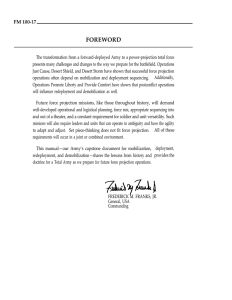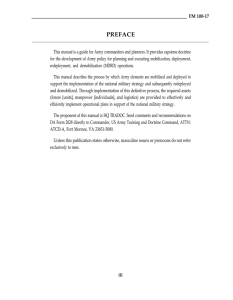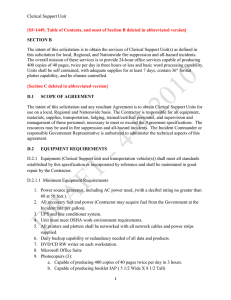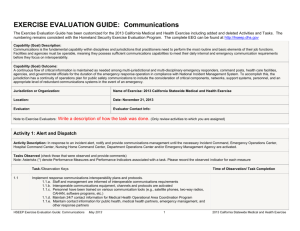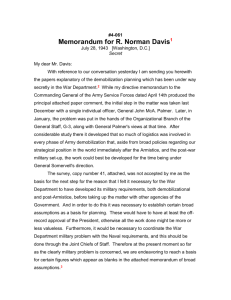DEMOBILIZATION
advertisement
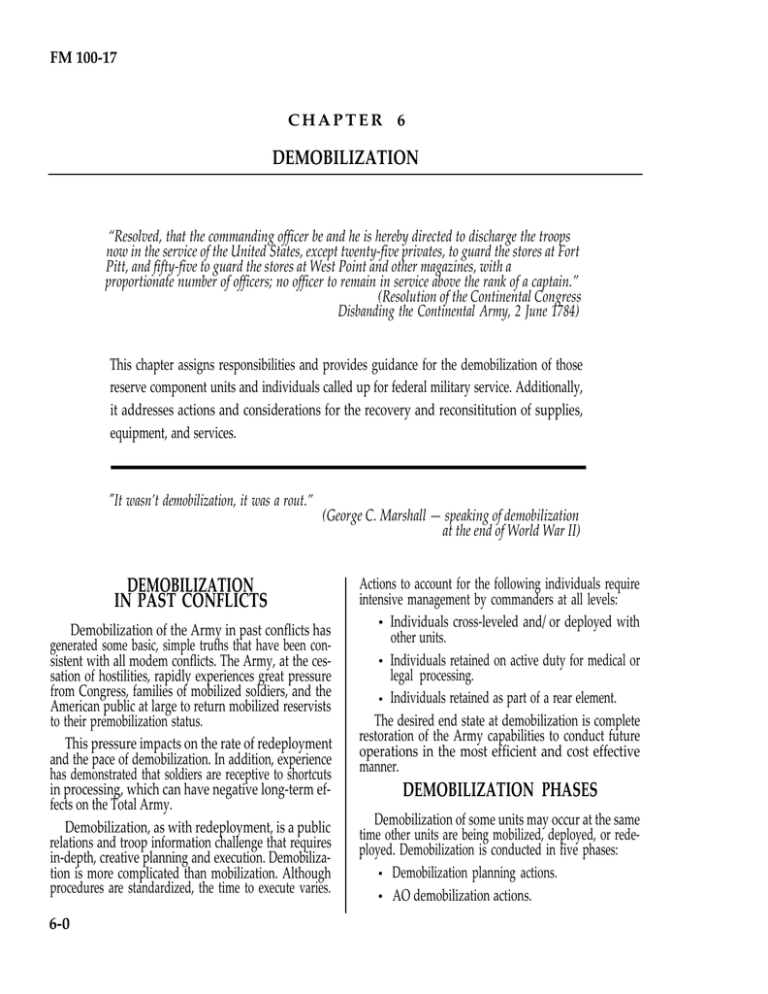
FM 100-17 CHAPTER 6 DEMOBILIZATION “Resolved, that the commanding officer be and he is hereby directed to discharge the troops now in the service of the United States, except twenty-five privates, to guard the stores at Fort Pitt, and fifty-five to guard the stores at West Point and other magazines, with a proportionate number of officers; no officer to remain in service above the rank of a captain.” (Resolution of the Continental Congress Disbanding the Continental Army, 2 June 1784) This chapter assigns responsibilities and provides guidance for the demobilization of those reserve component units and individuals called up for federal military service. Additionally, it addresses actions and considerations for the recovery and reconsititution of supplies, equipment, and services. "It wasn’t demobilization, it was a rout.” (George C. Marshall — speaking of demobilization at the end of World War II) DEMOBILIZATION IN PAST CONFLICTS Demobilization of the Army in past conflicts has generated some basic, simple truths that have been consistent with all modem conflicts. The Army, at the cessation of hostilities, rapidly experiences great pressure from Congress, families of mobilized soldiers, and the American public at large to return mobilized reservists to their premobilization status. This pressure impacts on the rate of redeployment and the pace of demobilization. In addition, experience has demonstrated that soldiers are receptive to shortcuts in processing, which can have negative long-term effects on the Total Army. Demobilization, as with redeployment, is a public relations and troop information challenge that requires in-depth, creative planning and execution. Demobilization is more complicated than mobilization. Although procedures are standardized, the time to execute varies. 6-0 Actions to account for the following individuals require intensive management by commanders at all levels: Individuals cross-leveled and/or deployed with other units. Individuals retained on active duty for medical or legal processing. Individuals retained as part of a rear element. The desired end state at demobilization is complete restoration of the Army capabilities to conduct future operations in the most efficient and cost effective manner. DEMOBILIZATION PHASES Demobilization of some units may occur at the same time other units are being mobilized, deployed, or redeployed. Demobilization is conducted in five phases: Demobilization planning actions. AO demobilization actions. FM100-17 POE-to-DMS or POE-to-CDC actions. DMS-to-CDC actions. Home-station or home-of-record actions. PHASE I - DEMOBILIZATION PLANNING ACTIONS Demobilization planning starts concurrently with mobilization planning and ends with the decision to release units and individuals from active duty. Demobilization planning encompasses an analysis of the workload required to efficiently complete the demobilization process over time. This planning may include— Relocating units and individuals. Incorporating annual training for nonmobilized RC units to support demobilization. Temporarily hiring civilian personnel. Mobilizing additional RC units. Using individual volunteers (via temporary tours of active duty) to support critical missions within the demobilization process. Demobilization planning in theater is based on the resources available to the ASCC. Critical resources include medical support, supplies, maintenance support, transportation support, personnel, and time. Plans must address basic equipment maintenance and disposition actions, decorations, awards, and evaluation report processing. The entire chain of command must communicate and enforce demobilization standards in theater. Failure to adhere to maintenance standards can cause delays in requisition fills and a unit’s inability to achieve mission capability upon its return to CONUS. PHASE II - AREA OF OPERATIONS DEMOBILIZATION ACTIONS This phase starts with reconstitution actions in theater and ends when the units and/or individual soldiers report to the POE for onward movement. The theater initiates administrative and logistics actions to ensure soldiers are cared for. Processing must include awards and decorations, performance reports, lineof-duty investigations, supply records, and equipment accountability. Medical and dental actions should be started in theater when resources are available. Units, to include filler personnel, should be programmed for movement to the DMS where the unit was initially mobilized. Individuals should be processed for movement to a designated CDC. PHASE III - PORT OF EMBARKATION-TODEMOBILIZATION STATION/CONUS DEMOBILIZATION CENTER ACTIONS This phase overlaps with redeployment phases to move soldiers to the DMS and/or CDC. An example of a demobilization process that may occur during this stage is a welcome ceremony for returning soldiers at the CONUS POD prior to arrival at the DMS/CDC. PHASE IV - DEMOBILIZATION STATION/CONUS DEMOBILIZATION CENTER ACTIONS This phase starts with arrival at the DMS and/or CDC and ends with the unit’s and/or individual’s departure to home station/home-of-record. Installations must house, feed, and provide on-site transportation to the units/individuals during this stage. Installation commanders ensure that all medical and dental actions, finance records, legal and entitlement briefings, personnel records updates, and logistics files are current before a soldier is released. Completion of required medical examinations, line-of-duty determinations, and finance actions to complete final pay are completed before issuing DD Forms 214. The rapid redeployment and demobilization of Operation Desert Storm resulted in numerous problems with reservists receiving incorrect DD Forms 214 and missing OERs/NCOERs. These problems resulted in additional resources being called up to screen all records at ARPERCEN and make necessary corrections. This action caused unnecessary confusion on the part of soldiers, units, employers, and federal agencies responsible for providing benefits. 6-1 FM 100-17 Installations must be prepared for expanded family support and media coverage of welcoming ceremonies during this stage. Welcome/departure ceremonies are vital components of the demobilization process that installations must plan and execute. Soldiers will remember the effort made to welcome them home. Installations should include families of soldiers as part of the ceremonies. Ceremonies should be brief but meaningful. Logistics actions include — Coordinating prescribed load list (PLL)/authorized stockage list accounts. Shipping equipment to home stations, equipment concentration sites, and mobilization and training equipment sites, as determined by the CONUSA in coordination with NGB and USARC. Preparing movement orders for unit members to return to their home station and individuals to their home of record. The CONUSA also issues a unit release from active duty (REFRAD) order during this stage. During Operations Desert Shield and Desert Storm, to include the redeployment and demobilization phases, installation family assistance centers were very active. As an example, the National Guard family assistance centers served over 250,000 people and answered over 350,000 telephone inquiries in support of members of all services. PHASE V - HOME-STATION/ HOME-OF-RECORD ACTIONS This phase begins with departure from the DMS or CDC and ends with release of units at their home station and individuals at their home of record. The unit reverts to RC status based on a date/time established by CONUSA orders, less ARSOF units that are released by USASOC. 6-2 Unit members are not always released at the same time. Transition leave, medical hold, rear detachments, and trail party personnel require different release dates. The specific release date for unit members is noted on their movement orders from the installation. Individuals are released from active duty on their return to their home of record. The end of this stage rolls into Phase 1 of mobilization planning (strategic reconstitution). During an extended conflict, RC units may lose their pure RC composition through extended cross-leveling, redistribution, and replacement actions. Mobilized RC units may contain USAR and/or ARNG personnel. Equipment may often be unidentifiable as being from active or RC sources. Once demobilization is initiated, HQDA identifies the DMS for all units (personnel and equipment). Units are then directed to return to the installation from which they originated or an alternate location. Active duty personnel are reassigned according to the HQDA reconstitution plan. Reserve units (flags) are released and soldiers assigned to the unit may be released or transferred to RC status as individuals. Strategic reconstitution of the total force is initiated as part of the mobilization planning phase. DEMOBILIZATION PROCESS Demobilization is the process by which forces (units), individuals, and materiel are transferred from active to reserve status. Although the focus is generally on units and individuals, significant resources, such as supplies, materiel, and support activities, are dedicated to the demobilization of logistics. Completion of equipment recovery operations and actions to reconstitute units to premobilization levels of readiness require additional resources, to include manpower support, funding, and time. Therefore, the demobilization process does not lend itself to a rigid approach and must be modified based on the situation governing the successful execution of the OPLAN/OPORD. FM100-17 Generally, four options are available for commands to demobilize units and redeploy their equipment CONUS units return to their home stations with their equipment. Personnel and equipment return together by air. Personnel return by air and the equipment follows at a later date by surface. Unit equipment scheduled to return to CONUS, but which does not accompany personnel, remains in an active Army equipment status until returned to the unit at its home station. Personnel return by air and all or a portion of the unit equipment remains in the AOR. Equipment remaining in the AOR is laterally transferred to either the supported commander or the gaining unit in country. UNITS RC units process through the same mobilization station used in the original call-up process. For purposes of demobilization, these installations are designated as DMSs. Deployed Units Units are released by the supported commander. Unit personnel redeploy back to an APOD and are returned to their original MS for demobilization processing. CONUS Support Units RC units providing support to the CONUS base are processed for demobilization by the same installations that accessed them to active duty. Personnel who were reassigned to serve in other locations or activities are reassembled with their units prior to demobilization. The supporting commander, in concert with the supported commander, determines the priority for equipment return, that is, recommends the transportation mode. FORSCOM, NGB, and other MACOMs, in order to maintain a readiness posture, coordinate and provide minimum essential equipment for training (MEET) sets or transfer equipment to units whose equipment was retained in the theater. Supporting installations with A/DACG or PSA responsibilities assist unit personnel and equipment during transit from the POD to the DMS. DMSs are required to plan for support of units in all areas of supply, to include reestablishing basic load requisitions and PLL accompanying equipment and replenishing individual equipment which was retained in the AOR. INDIVIDUALS All RC soldiers and retirees called as individuals to serve at CONUS installations are demobilized from those locations. RC fillers returning with the unit of assignment to its installation of origin (home station for AC units or MS for RC units) are released from active duty at that location. Filler personnel do not accompany an RC unit to its home station. When appropriate, the DMS coordinates with the appropriate installation, based on the individual’s original unit of assignment, to acquire records to accomplish demobilization actions. Reassignment of civilians occurs simultaneously with demobilization of reservists. HQ DA issues specific guidance on returning civilians to their previous duty station and release of contractors. LOGISTICS Demobilization, as it pertains to logistics, is the process of restoring equipment and supplies to a prescribed level of readiness and placing them in the location which best supports future plans or contingencies. The desired logistics end state at demobilization is complete restoration of equipment to conduct future operations in the most efficient and cost-effective manner possible. Supplies and Materiel Operational requirements or transportation constraints may determine that some organizational or individual equipment remain in the AO. However, recovery of all supplies and materiel should be given as high a priority as practical. Demobilization Stations The DMS receives and issues supplies and equipment to RC units as they return from the theater. Assets and assistance may be provided for maintenance and repair prior to issue to receiving units. 6-3 FM 100-17 MACOMs determine when RC units supporting the redeployment and demobilization processes are released from active duty. The 5064th US Army Garrison (Army Reserve, Livonia, MI) and the 2361st Signal Detachment (Army Reserve, Akron, OH) were mobilized in support of Operations Desert Shield and Desert Storm. They were deployed to Fort McCoy, WI, a mobilization station, and provided mobilization and demobilization support at the installation. Equipment and Supply Demobilization and Storage Redeployed equipment and supplies not returned to using units are redistributed according to plans developed by HQDA with input from combatant commanders. Priority is generally to Army forces committed to JCS-approved OPLANS. Other recipients may include USAMC, DLA, and GSA distribution centers. In the redistribution process, equipment may be available for HQDA Foreign Military Sales or a grant program as excess defense articles to support national interests and policies. Equipment may be distributed to Army commands in a serviceable or unserviceable condition. In the latter case the receiving command is normally responsible for returning it to a serviceable condition. HQDA establishes distribution, funding, project codes, and priorities for the maintenance and supplies to maintain and repair the returning equipment. Outstanding Contracts Based on logistical needs, current Army contracts will be reviewed to determine continuing applicability. Some will need to be continued to replenish stocks used during the conflict, and others may be readjusted or cancelled based on requirements. In some cases, it may 6-4 be more cost effective to fulfill a contract than to cancel noncritical items. It maybe necessary to shift funding for demilitarization projects from noncritical programs to ones with a higher priority. In all cases, the review of contracts must be viewed with the best interests of the nation and the Army in mind. Facilities and Work Force The demobilization of industrial facilities and the associated work force is related to initial mobilization requirements. Under contingency responses, the industrial base may be expanded only with temporary employees and leased facilities. Upon cessation of hostilities, this temporary capability would be contractually released from service and the tools stored for future use. Large-scale mobilization might entail the construction of new government-owned facilities and the training of a skilled work force in new technologies similar to the World War II Manhattan Project for the building of the atomic bomb. Demobilization of an effort of that size would require an integrated governmental plan that might transfer military activities to other agencies or commercial interests. Additional efforts may involve demilitarization projects to dispose of undesirable or obsolete weapon systems. SOLDIER SUPPORT Personnel actions to demobilize RC personnel are planned to support the transition of the soldier into civilian life. The most critical actions center on medical and finance processing and issuance of separation documents (DD Forms 214). These actions represent a legal relationship between the Army, the soldier, and the soldiers’s civilian employer and must be completed to the highest standard. Other personnel actions (awards processing, OER and NCOER processing, and records update) are completed prior to demobilization. The DMS must conduct a review of all such actions completed in the theater. This review is to ensure that all required actions are completed prior to REFRAD. FM 100-17 Family support focus shifts to family reintegration and crisis intervention. Impressions formed by spouses and family members during this experience have a critical impact on the soldier’s continued participation as a member of the RC. Finance support during demobilization is just as important as during mobilization and ensures a smooth soldier transition back to RC pay status. Actions by the RC commander include — Reviewing any pending pay actions of his soldiers. Ensuring that each soldier is aware of his entitlements. Ensuring that Class A agents reconcile their accounts. Finance personnel outprocess demobilizing soldiers by computing and paying all final entitlements and travel claims. In addition, they convert soldiers from AC to RC status on JUMPS/JSS or separate those individuals reverting back to full time civilian status from JUMPS/JSS. The Army’s responsibilities to care for soldiers during demobilization does not end upon a soldier’s release from active duty. In conjunction with the Department of Labor, the Army helps and ensures that returning soldiers receive all reemployment and other entitlements guaranteed by law. The 541st Adjutant General Company (Personnel Services Administration), Washington ARNG, was called into federal service on 25 January 1991. At that time its mobilization station was changed from Fort Lewis, WA, to Fort Ord, CA. The unit arrived at Fort Ord on 30 January 1991 and sewed there as a CONUS support unit assigned to I Corps and attached to the 7th lnfantry Division (Light). The unit processed Army National Guard, Army Reserve, and Individual Ready Reserve soldiers’ records, both for mobilization and demobilization. The 541st processed the records of about 2,500 soldiers for demobilization. On 5 June 1991, the unit was released from active duty at Fort Oral. Planning for media coverage of demobilization and reception activities must focus on a combination of local and national media. SUMMARY Demobilization is a critical factor in the Army’s strategic reconstitution. Demobilization must be planned with the same degree of energy and detail as mobilization. Effective demobilization enhances readiness and soldier morale. The Army, through demobilization, reaffirms its long-term commitment to a viable reserve. 6-5
